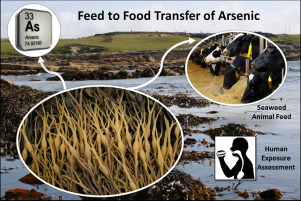Environment International ( IF 11.8 ) Pub Date : 2018-06-20 , DOI: 10.1016/j.envint.2018.05.032 Michéal Mac Monagail , Enda Cummins , Ricardo Bermejo , Eve Daly , Declan Costello , Liam Morrison

|
Seaweed has a long-associated history of use as a supplemented livestock feed, providing nutrients and vitamins essential to maintaining animal health. Some species of seaweed, particularly the fucoids, are well-known accumulators of the metalloid arsenic (As). Arsenic toxicity to humans is well established even at low exposure levels and is considered a class 1 human carcinogen. As mankind's appetite for livestock produce continues to grow unabated, there is a concern that consumption of livestock produce reared on a diet supplemented with seaweed animal feed (SAF) may pose a threat to the human population due to potentially high levels of As present in seaweed. To address this concern and provide end users, including industry, consumers, policymakers and regulators with information on the exposure associated with As in commercial seaweed animal feed, the estimated daily intake (EDI) of As was calculated to evaluate potential human exposure levels. Using As data from a commercially available seaweed meal over a five-year period (2012–2017) a population exposure assessment was carried out. A Monte Carlo simulation model was developed to characterise the feed to food transfer of As from animal feed to animal produce such as beef, milk, chicken, and eggs. The model examined initial levels in seaweed, inclusion rate in animal feed, animal feeding rates and potential transfer to food produced from a supplemented diet of SAF. The analysis of seaweed animal feed showed that inorganic As was a small fraction of the total As found in seaweed meal (80:1). Statistical analysis found significant differences in the concentration of As in seaweed animal feed depending on the grain size (p < 0.001), with higher As concentrations in smaller sized grain fractions. Due to several detoxification steps and subsequent rapid excretion from the bodies of livestock, a very low carryover rate of As compounds from seaweed animal feed into livestock produce was observed. The EDI calculated in this study for the livestock produce evaluated at the 95th confidence interval was <0.01% of suggested safe levels of inorganic As intake. The threat to the general population as a result of consumption of livestock products reared on a diet consisting of SAF is found to be negligible.
中文翻译:

商业海藻饲料中总砷和无机砷的定量和饲料食品转移
海藻作为补充牲畜饲料具有悠久的历史,可提供维持动物健康必不可少的营养素和维生素。一些种类的海藻,尤其是岩藻类,是类金属砷(As)的众所周知的蓄积剂。即使在低暴露水平下,砷对人的毒性也已得到充分证实,被认为是1类人类致癌物。随着人类对畜牧产品的食欲持续增长,人们担心食用补充了海藻动物饲料(SAF)的饮食饲养的畜产品可能会威胁到人类,因为海藻中可能存在高水平的砷。 。为了解决此问题并向最终用户(包括行业,消费者,政策制定者和监管者)提供有关商业海藻动物饲料中As暴露的信息,计算得出As的估计每日摄入量(EDI)以评估潜在的人类暴露水平。使用五年内(2012-2017年)的市售海藻粉数据作为人群暴露评估进行了。建立了蒙特卡罗模拟模型,以表征从食物到动物产品(如牛肉,牛奶,鸡肉和鸡蛋)中砷从食物到食物的转移过程。该模型检查了海藻的初始水平,动物饲料中的夹杂率,动物喂养率以及向补充SAF饮食生产的食物的潜在转移。对海藻动物饲料的分析表明,无机砷仅占海藻粉中总砷的一小部分(80:1)。统计分析发现,海藻动物饲料中As的浓度存在显着差异,具体取决于晶粒尺寸(p <0.001),而较小尺寸的谷物中的As浓度较高。由于几排毒步骤以及随后从牲畜体内快速排泄,观察到海藻动物饲料中的As化合物残留到牲畜产品中的残留率非常低。在本研究中,对在第95个置信区间内评估的牲畜产品计算出的EDI小于建议的无机砷摄入安全水平的0.01%。人们发现,食用由SAF组成的日粮饲养的牲畜产品对普通人群的威胁可以忽略不计。



























 京公网安备 11010802027423号
京公网安备 11010802027423号